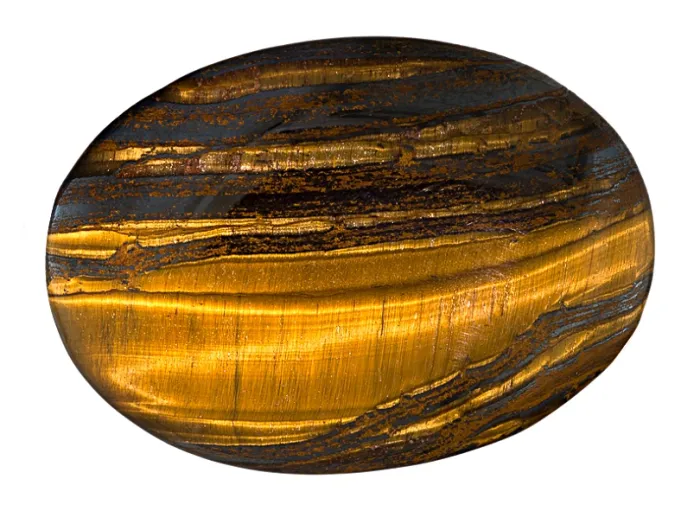
Appearance
Tiger’s eye usually has hues ranging from golden to reddish-brown, frequently with parallel stripes or bands of different intensities. Its name comes from the most frequent color, which is golden-brown and has tints and patterns similar to a tiger. Though they are less common, blue and green forms of tiger’s eye can also be found.
The luster of the tiger’s eye is silky to glossy. When polished, its surface might appear reflective and smooth, which improves its appearance.
Geographical Distribution
Tiger’s eye can be found all over the world in different places. Tiger’s Eye is found in several major geological locations, including South Africa, Australia, the United States, Brazil, and India. Other nations where Tiger’s Eye is found include Namibia, Madagascar, Myanmar (Burma), and China. The supply of Tiger’s Eye gemstones around the world is aided by several sources.
Metaphysical Properties
Tiger eye is thought to create a powerful stone that is also firmly grounded by fusing earth energy with light or sun energy. Tiger eye is believed to provide unwavering protection for its user and to strengthen psychic and empathic abilities.

Chemical Composition
The crystalline gemstone known as tiger’s eye is a member of the quartz family. The main component of it is silicon dioxide (SiO2). Tiger’s eye, often known as “tiger eye,” is a chatoyant gemstone that typically has a golden to reddish-brown color with a silky sheen. It is a metamorphic rock.
Types
Here are a few notable ones:
Golden Tiger’s Eye:
This is the most popular and well-known type of tiger’s eye. Its base color ranges from golden to brownish-yellow, accented by parallel bands or stripes of black or darker brown. Golden tiger’s eye is known for its exquisite chatoyant effect, which gives the appearance of shimmering.
Red Tiger’s Eye:
This type, often called Ox Eye or Bull’s Eye, features reddish-brown to deep crimson hues. It frequently displays the distinctive chatoyancy of jewels made of tiger’s eye. The iron oxide that is present in the stone is what gives it its red color.
Blue Tiger’s Eye:
Hawk’s eye, or blue tiger’s eye, is a less common variant. Due to the presence of iron minerals, it has a base color that ranges from blue-gray to bluish-green. Blue tigers’ eyes frequently display the chatoyant effect, which is a strip of light that moves over their surface. This particular variety of Tiger’s Eye has a distinctive and alluring quality due to its blue hue.
Green Tiger’s Eye:
Another rare variation that exhibits a range of green tones, from light green to deep olive green, is called Green Tiger’s Eye. The iron minerals that are present in the stone also contribute to its green hue. The chatoyant effect, which presents an arresting interplay of light and color, can be seen in the green tiger eye.
Tiger Iron:
Tiger’s Eye, red jasper, and black hematite are combined to create this unusual combination stone. It has bands of metallic black hematite, red jasper, and golden Tiger’s Eye that alternate. This variation creates a stunning and unique pattern by showcasing the qualities of all three minerals.
Uses
Here are some common uses of Tiger’s Eye:
- Jewelry: The use of the tiger’s eye in jewelry creation is very common. It is frequently utilized in several jewelry items, including pendants, bracelets, necklaces, earrings, and rings. Due to its distinct chatoyant effect and eye-catching hues, it is a highly sought-after gemstone for jewelry intended for both genders.
- Decorative Objects: Additionally, tiger’s eye is utilized in ornamental goods and décor. It is fashioned into sculptures, cabochons, and carvings for use in paperweights, figurines, and other artistic works, as well as home décor. These items have an air of refinement because of the stone’s eye-catching hues and fascinating patterns.
- Fashion Accessories: Tiger’s eye can be used in accessories other than jewelry for your wardrobe. It adds a dash of uniqueness and organic beauty to personal style when used to make belt buckles, cufflinks, keychains, and other accessories.
- Feng Shui: Tiger’s eye is thought to offer security, wealth, and good fortune in Feng Shui, the traditional Chinese practice of balancing the energies in one’s surroundings. In order to draw good energy and improve the flow of chi, it is frequently employed in house décor and placed in particular locations.
Table





